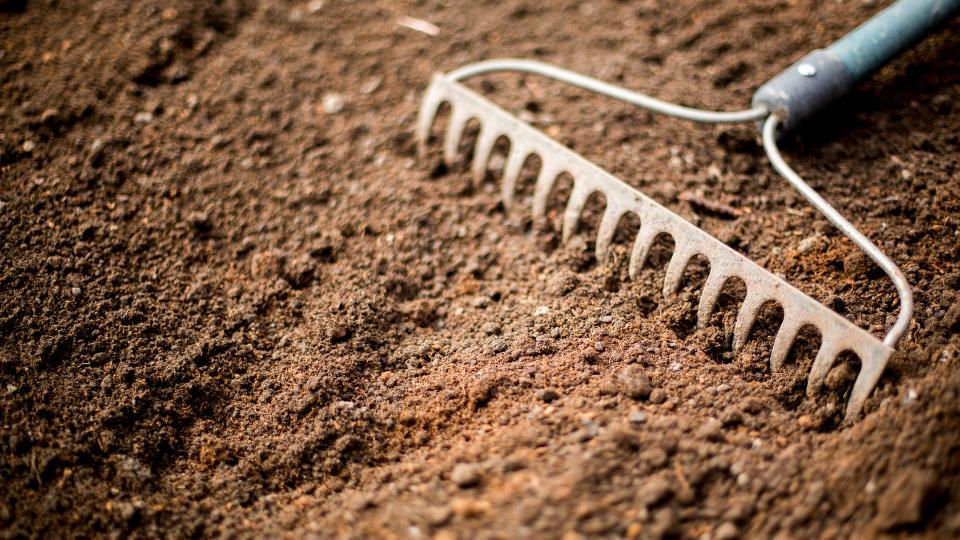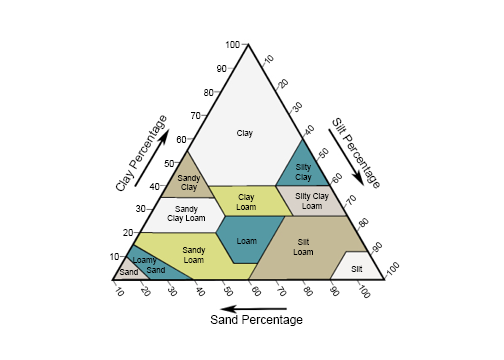Water-wise Landscape Implementation

Soil: Your Landscape’s Foundation
As your landscape begins to move from the design to implementation stage, an understanding of the site conditions is critical. Soil is one of the most fundamental elements of a landscape and understanding the characteristics of soil can significantly increase your ability to capture, store, and use water efficiently within your landscape. You can learn some important things about the soil just by looking at it and feeling its texture; however, to gain a more complete understanding of its capacity and limitations, you may want to have your soil tested.
Soil Testing
When having a soil test performed, it is best to choose a local lab. Soils in the arid Western United States should be tested differently than acidic soils from the East. Sending soil samples to a lab outside your own region can result in inaccurate test results.
Utah State University Analytical Laboratories perform soil testing for the public, please refer to their website for instructions on collecting and sending a sample to the lab. If you need additional resources, you can also always ask your local Extension office for help.
Several properties of a soil influence the way it functions within the landscape and how it is able to store and transfer water. These properties include texture, structure, fertility, pH, salinity, and compaction. We will discuss each of these in more detail.

Soil texture refers to the relative sizes of the soil particles and is classified by the relative percentages of sand, silt, and clay in the soil. Sand particles are the largest and create a soil with quick drainage. This kind of soil texture will allow water to quickly absorb into the soil, but water will pass through the soil quickly. Clay particles are the smallest. Clay soils drain more slowly but retain nutrients more readily. Water will be absorbed slowly in soils high in clay, and water is likely to run off of this soil type rather than soaking in. Conversely, soils with high clay content will retain water within the soil and can create areas that remain muddy and wet long after a precipitation event. Silt particles are in between sand and clay particles in size.
Loamy soil has a balance of the three particle sizes. It is generally considered the ideal soil type for plant growth. Soils with a loamy texture are able to hold a balance of water and oxygen within their pore space. While a loamy soil may be ideal, it is possible to grow plants in other soil textures.
It is never recommended to try to change a soil’s texture by adding sand to a clay soil or clay to a sandy soil. The usual result of such attempts is a hard, concrete-like texture less suited for plant growth than before. It is more effective to adjust soil texture with the addition of organic material such as compost. Organic matter will help sandy soils hold water more efficiently. Organic material will also improve clay soils by breaking up the solid soil profile and allowing easier movement of water and oxygen through the soil.

Soil structure refers to the way soil particles clump together into aggregates. These clumps create pore space that allows water and oxygen to move through the soil and is vital for plant health.
The addition of organic material suggested in the previous section is beneficial because of the way it improves soil structure. Organic material helps soil particles of any size to form aggregates. This improved soil structure allows water to infiltrate and be held within the soil profile.
Soil fertility is the presence of nutrients in the plant-available form within the soil. It is possible to enhance soil fertility through adding natural or chemical fertilizers or practices like cover cropping and plant nitrogen fixation. Amending the soil can be both expensive and time-consuming. It is therefore beneficial to have the soil fertility tested to understand exactly what is needed for optimum plant growth.
Many native and water-wise plant varieties require low levels of plant nutrients. It may not be necessary to add large amounts of additional nutrients.
Another characteristic of soil that we can determine through soil testing is pH. The pH scale refers to the potential of hydrogen and is a quantitative scale of acidity. On the scale, 7 is neutral. Soil that measures below 7 is considered acidic and soil above 7 on the pH scale is considered basic or alkaline. Many plants prefer soil that is neutral or slightly acidic. Others prefer or at least tolerate alkaline conditions.
Most soils in Utah are calcareous which means they contain large quantities of calcium from limestone. Calcareous soils are strongly alkaline. Due to the buffering capacity of the calcium in a limestone-derived soil, adding organic material is one of the few practical ways of neutralizing the high pH.
Salinity is another soil characteristic that should be considered when implementing a landscape. Plants prefer soils without excess salts, but different species have varying tolerance for saline conditions. The overuse of chemical fertilizers can add salts to the soil. As salinity increases, soil chemistry changes, and its water holding capacity can be adversely affected.
The final soil property to consider is compaction. Compaction reduces the pore space in the soil. This can make the exchange of gasses and the infiltration of water into the soil difficult.
Most soil compaction in the landscape is caused by human interaction. Creating an effective landscape design and maintenance plan are important ways of decreasing compaction.
A well-conceived landscape design will incorporate a plan for circulation through the site. Conveniently placed paths will help eliminate the need to walk or drive over grass and through planting beds. Turf areas that receive significant foot traffic should be regularly aerated to reduce compaction.
If managed poorly, the landscape installation process could also lead to an increase in soil compaction. Whenever possible, restrict the movement of heavy equipment through the site.
Adding Organic Material
Adding organic material, usually in the form of compost, is one of the best ways to enhance the soil. Organic material can improve the soil texture and structure, increase fertility, neutralize pH and salinity, and reduce compaction. The initial installation of the landscape is an opportunity to incorporate organic material into the soil.
Be strategic about adding compost to your landscape. It can be an expensive and time-consuming process. Focus on adding organic material to soil that will become turf or planting areas. It is less important to improve soil that will become a pathway or be covered with gravel.
Mulching
Mulching is another way of improving soil health and conserving water. A layer of mulch can reduce evaporation and help the soil hold moisture. Mulches made from natural materials break down over time and add organic material to the soil.
An attractive mulch can also provide a neutral backdrop that allows plants to become a focal point. As a landscape matures, the plantings can outcompete weeds. During the initial installation phase, the mulch layer helps shade out and suppress weed seedlings.
It is important to plan for mulch as the landscape is being implemented. Remember to account for the mulch layer in the elevation of pathways and edging and in the placement of plant materials. Often plants are installed with the top few inches of the root ball exposed. Once the area has been mulched, the root crown is even with the finished grade level.
Right Plant, Right Place
One of the most crucial steps in any landscape design is finding the right plant for the right place. This means all the plants in a landscape should be chosen purposefully. They should not be chosen because they look good in someone else’s yard or because they happened to be blooming during a visit to the nursery.
They definitely should not be chosen because they were on sale at the end of the season.
Choosing the right plant means that each selection should fill a specific role within the landscape design. Plants can provide shade or screening. Their color can add seasonal interest or a focal point. Certain plants can create a ground plane surface, and others add height and a sense of scale to an outdoor space. Still other plants can bring texture or scent to the garden. Finally, plants are a source of food for both humans and beneficial insects.
Evaluate the water needs of each plant variety used in the landscape. The plants should fill a role in the landscape and a role in an overall water plan.
Native Plants
Any discussion of water-wise landscapes should include the topic of native plants. There are some advantages to using native plants in a landscape design worth considering. The plants are obviously adapted to the region. Once they have become established, native plants often only require supplemental irrigation during periods of extreme drought.
Sometimes the retail marketing of native plants can be a little confusing, so it can be helpful to do some research before buying. Species within a genus are not always native to the same region. For example, there are oak and hackberry trees native to Utah; however, not all species of oak or hackberry are native or particularly well suited to the region.
Utah is home to several very distinct native plant communities. Though we share a geographical boundary, not all plants native to the state are well-adapted to all parts of the state. For instance, species native to Utah’s mountains can do poorly when brought to the desert valleys.
It is also worth mentioning that it is never advisable to attempt bringing home plants from your outdoor excursions. Transplanting native species can be tricky, and your efforts are likely to be unsuccessful. It is also illegal to remove plant materials from federal and state lands and national wildlife areas. It is better to enjoy native plants in situ and leave the ecosystem intact.
However, it is possible to learn from outdoor travel experiences. Observing a natural landscape can inform the best uses of native plant materials in a designed landscape. It is also possible to recognize combinations of plants that work well together in a plant community.
Another consideration when purchasing native plants is understanding how the green industry may have altered them. There are now cultivated varieties of many native plant species. In many instances, these cultivars have improved characteristics like larger flowers or a more regular form. In some instances, however, the newer variety has lost some of the cold hardiness or drought tolerance of the original species.
Plant Selection Considerations
While there are many advantages to native species, sometimes the right plant might be a variety introduced from another region. A few things to consider when choosing any plant for a water-wise landscape are: Does it fit in the design? How will it perform in its assigned hydrozone? and Can it become invasive?
The first of these considerations is how will the plant fit into the design. Consider the plant’s size, form, color, and texture to determine if it will fit in the space it is intended and function within the landscape.
Next, it is important to consider how much water the plant needs to maintain healthy growth. It is also important to consider the water requirements of all the plants in a specific zone. Plants in the same hydrozone should have similar water requirements. It is typical to adjust watering for the thirstiest plant in a hydrozone. Including one species that requires higher water inputs will reduce the water savings for the entire area. For some species of desert plants, overwatering can actually be detrimental to the plant’s health.
A final consideration is if the plant may become invasive. Many introduced species that have become invasive are superbly adapted to the climate where they pose a problem.
Authors
Related Research


 Utah 4-H & Youth
Utah 4-H & Youth



